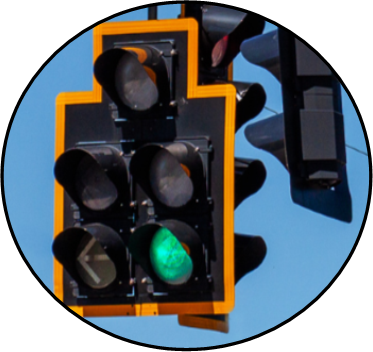
Signal Spotlight: The Role of Traffic Signals in Traffic Incident Management
What Is Traffic Incident Management (TIM)?
A traffic incident is a non-recurring event that creates a reduction in highway capacity and/or an increase in demand. Incidents can include traffic crashes, disabled vehicles, spilled cargo, highway maintenance or construction, non-emergency planned events, emergencies and major weather events.
In Best Practices in Traffic Incident Management published in September of 2010, FHWA defines Traffic Incident Management (TIM) as “a planned and coordinated multidisciplinary process to detect, respond to, and clear traffic incidents so that traffic flow may be restored as safely and quickly as possible.” As such, Traffic Incident Management requires extensive coordination between many stakeholders including law enforcement, fire and rescue, emergency medical services (EMS), transportation agencies, towing and recovery personnel, and communications specialists.
According to the National Traffic Incident Management Coalition (NTIMC), which was established in 2004, the National Unified Goal for traffic incident management is:
- Responder safety;
- Safe, quick clearance; and
- Prompt, reliable, interoperable communications.
Why Is TIM Important?
Traffic incidents account for approximately 25% of non-recurring congestion on America’s roadways. This congestion has economic impacts to road users in the form of increased fuel costs and vehicle emissions. These costs are often compounded when additional crashes occur.
Secondary crashes, or crashes that occur as a result of distraction or congestion from a prior incident, are responsible for 18% of all fatal traffic crashes in the United States according to FHWA. Incident scenes place first responders in a vulnerable position on an active roadway. The National Traffic Incident Management Coalition (NTIMC) has found that traffic crashes and struck-by incidents are leading causes of on-duty injuries and deaths for law enforcement, firefighters, and towing and recovery personnel.
Traffic incidents follow a typical timeline, beginning when the incident occurs and ending when traffic flow returns to normal. The NTIMC has found that after an incident has cleared, four minutes of travel delay are created for every minute a freeway travel lane was blocked during the peak period. The longer the incident, the greater the cost and risk of injury or death to responders.
The Role of Traffic Signals in TIM
As you can see in the diagram above, providing traffic management and motorist information plays an important role throughout the timeline of a traffic incident. While traffic signal timings on a detour route may not significantly impact the overall duration for shorter incidents, a longer-lasting incident with significant impact may be shortened by implementing optimized traffic signal timing along the detour route.
TIM operations are managed using a structured Incident Command framework that is often led by law enforcement officials with support from various other stakeholders including fire and rescue personnel, emergency medical services (EMS), transportation agencies, towing and recovery personnel, and communications specialists. As noted in the Simplified Guide to the Incident Command System
for Transportation Professionals, Command considers the following three priorities:
- Life Safety – protecting emergency responders, any incident victim, and the general public.
- Incident Stability – Minimizing an incident’s impact on the surrounding area, maximize response efforts, and ensure efficiencies in using resources.
- Property Conservation – Minimizing damage to property while still achieving established incident response objectives.
The role of transportation professionals in TIM includes modifying traffic signal timings to reduce congestion, providing information to Incident Command using data available through a Traffic Management Center, and advising motorists using variable message boards, highway advisory radio and internet resources like online mapping and social media.
Modifying the signal timings at intersections along a detour route allows agencies to give priority to a specified movement to increase throughput by increasing the green times on those approaches. This may be effective for “flushing” traffic from a freeway or allowing faster evacuation from an affected area. Information on using signal timings for evacuation operations may be found in the FHWA publication Using Highways During Evacuation Operations for Events with Advance Notice.
Transportation professionals operate Traffic Management Centers (TMCs) in metropolitan areas, monitoring real-time traffic conditions to help identify incidents quickly and assess the impact of traffic signal timing changes. Providing this information requires communications to a central operations center, central software, detection to measure traffic volumes, and cameras for detection and monitoring of events. Municipalities operating the same central software can improve regional operations by sharing data between agencies.
TIM Efforts in Connecticut
Traffic Incident Management is currently one of seven emphasis areas within the Connecticut Strategic Highway Safety Plan. At a regional level, the Capitol Region Council of Governments (CRCOG) oversees the Greater Hartford TIM Coalition that includes both public and private stakeholders. Recent activities undertaken by the coalition include development of a TIM Field Pocket Guide for use by practitioners in the field, updates to the Greater Hartford Region Unified Response Manual, and updates to regional diversion plans for freeway incidents. The Greater Hartford TIM Coalition also publishes several newsletters each year which may be accessed from the Coalition’s website.

In collaboration with CTDOT and the Greater Hartford TIM Coalition, the T2 Center will be hosting TIM Training on September 29th and September 30th with Aidan Neely of CTDOT as the instructor. To register, visit the Workshop Calendar on the T2 Center website.
If you have traffic signal systems questions, please contact:
Theresa Schwartz, P.E., P.T.O.E. – Traffic Signal Circuit Rider
theresa.schwartz@uconn.edu.

